What makes a Wade, a Wade?
We are no longer building saddle trees, but we have two videos about how Western saddles fit horses available on our westernsaddlefit.com website.
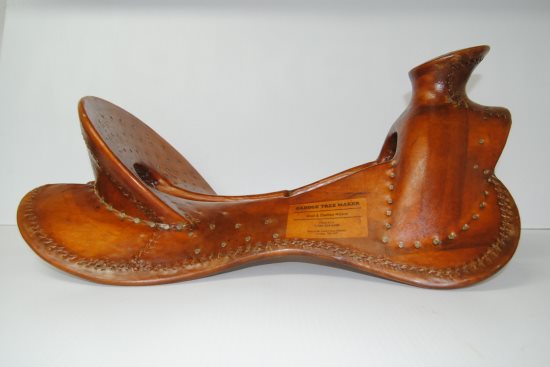
The Wade style of saddle has become very popular over the past 20 plus years and, as with anything popular, many misconceptions get spread around about it. Some people say that a Wade saddle fits a horse differently than other saddles. You will hear that the seat in a Wade saddle is different than other saddles. If you read the internet, you are told you are closer to your horse in a Wade saddle than any other kind. And on, and on... What is the truth? The following information has always been available on our page on Wade forks, but since the topic has come up in discussions with customers about four times in the past two weeks, I thought I would reiterate it here with more pictures to try to make it clear - from our viewpoint anyway.
Where do the misconceptions come from?
There are a lot of saddles being sold with the label of "Wade", because, lets face it, that is a big marketing tactic at the moment. A lot of misinformation about Wades - like how they fit the horse and the rider - probably have come about because originally it was not a common style of saddle. It was used primarily by working cowboys which were, and still maybe are, the primary customers for hand made trees. Cowboys who work long hours in their saddles day after day understand the value of a well fitting saddle for their horse and a well made ground seat for them - and the place you get the best of those is a custom saddle maker. So many of the earlier Wade saddles were truly custom saddles built on very high quality trees, and so they did fit both the rider and the horse better than the typical production saddles of the day.
But - things have changed. With the popularity of "the Wade", production saddle makers of all types and qualities have been turning out "Wade" saddles for a number of years now. However, just because it has that tag on it doesn't mean it really has the characteristics that define a true Wade fork. The true hand made trees pretty much stick to these factors still, but production trees? We'll just say "Not so much" - as a general rule anyway...
The factors that define a Wade tree
So when you look at the saddle, here's what you need to check out. At the most basic level, a Wade is 1.) a style of fork, which is 2.) a slick fork with 3.) a wood post horn built in as an integral part of the fork, which means you can have 4.) a thin gullet. A true Wade also has 5.) thicker stock than other slick fork trees, which means it needs 6.) a higher top cut angle than other slick fork trees. It also has 7.) a wider side cut angle. Allow me to elaborate...
1.) It is strictly a style of fork.
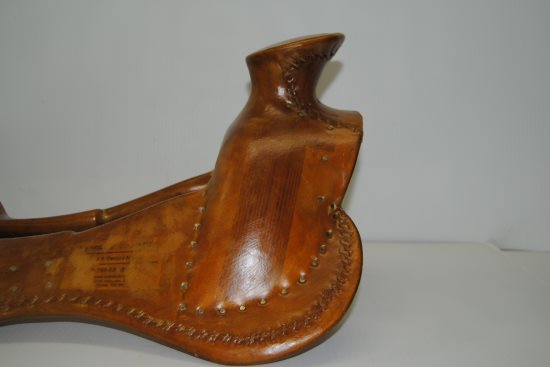
While the first Wade tree brought to Hamley’s in the 30’s and copied by Walt Youngman had a specific style of cantle, bars and fit, (after all, there was only one of them!), this is not true of Wade saddles on the market today. They do not fit horses differently than other tree styles. Any type of bar can, and is, put under a "Wade" shaped fork depending on the tree and saddle maker. The “Wade bars” (and what's in a name anyway?) that are often used with Wade forks generally have a longer front bar tip to accommodate the extra stock thickness, but not always. The outline pattern that a lot of makers use under a Wade fork often has more surface area than their other bar types, but not always. Everything about the bar is independent of the style of the fork. Just because it has a Wade fork on it doesn't mean it has different bars in it than saddles with other forks, and "Wade bars" can be put under different fork styles. All the Factors That Affect Tree Fit apply equally to every style of fork, including Wades. It all depends on the tree maker - and every tree maker does things differently.
In the same way, the seat the rider feels is a result of the work of the saddle maker, not the shape of the fork. In a western saddle, what the rider feels is based on the ground seat (or lack thereof) that a saddle maker puts on top of the tree. (We have seen "seats" made of 1/8" of foam and the seat leather on top of a built in ground seat on a synthetic tree. Not much effort into that "ground seat"...) A good saddle maker can put a good seat in any tree style - and a bad saddle maker can put a bad seat in any tree style. Now, some companies may have a certain seat shape that they like to combine with a certain fork shape - or not - but that is strictly that company's choice. There is no seat shape that goes along with a Wade fork. Wade forks do not mean you sit closer to your horse, more balanced on your horse, or any of the other statements you commonly read on the internet. The shape of the seat under the rider is totally independent of the shape of the fork.
2.) It is a slick fork.
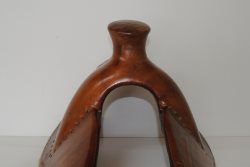 |
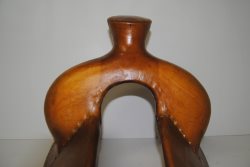 |
A slick fork is widest at the bottom of the fork. If it goes wider anywhere down its sides and then comes in to meet the bars, it is a swell fork, regardless of the name that is on it. Although the original Wade fork was a specific shape and “width”, they are now made in various “widths” from very slick to almost a swell. “Width” is in quotation marks because there is no consistent place to measure a slick fork, so every tree maker's “X width” will look a bit different. You have to go by the pictures to decide what you want to order from each maker. We commonly make forks from 8” to 10” wide at ½” increments (10" being as wide as you can go without becoming a swell fork). But we have made them slicker and we have also combined the rest of the attributes of a Wade with different swell fork patterns to make narrow swell forks, which we do not call "Wade", or Swade either...
3.) It has a wood post horn built in as an integral part of the fork.
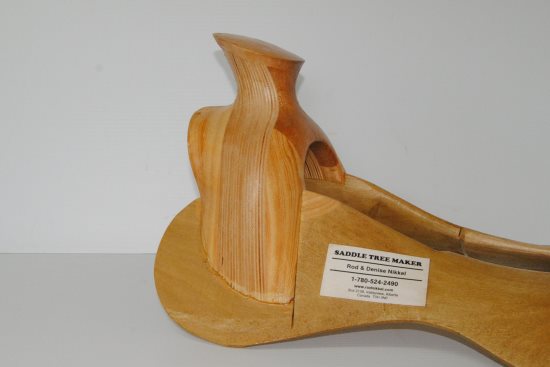
It is not uncommon to see saddles labeled as "Wade" which obviously have metal horns on them. You can even purchase horns, usually aluminum, called "Wade horns" which are made large enough to look like a wood post horn. As well, you can have wooden horns on a slick fork style, but the horn is added in later. They don't start with one chunk of laminated wood which ends up as the fork and horn combined. (You can check out our Building a Wood Post Horn Fork page for pictures of how we build one.) But - as soon as you attach a metal horn or add a wood post horn as a separate piece to a fork, you change the main factor that gives an Wade tree an advantage in roping over most other styles of fork, and that factor is that - (drum roll please...)
4.) It has a thin gullet.
A metal horn needs to be attached to the wood of the fork somehow. Many are attached with screws, as we do, so you need a gullet thick enough to accommodate the length of screws you use so they won't stick out the bottom of the gullet. Some production makers bolt the horns on through a hole drilled through the fork, with or without a metal plate on the bottom. If a wood post horn is added separately to a fork, that means they also have to drill out a hole in the fork, often a fairly big hole, to dowel in the horn. Drilling holes through wood weakens it - that is a basic fact - so again they need a thicker gullet to be strong enough to stand up to use when they do this. (There is a picture of this type of construction about half way down this blog post.)
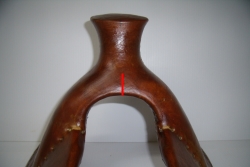 |
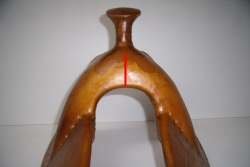 |
However, when a Wade fork is properly made, with the wood post horn an integral part of the fork, you can really cut down the gullet thickness, especially if you use good quality hardwood and/or multiple laminations which make the whole thing very strong. For our trees, we mark out 2 1/8" of wood between the top of the hand hole and the top of the fork at the back of a metal horn fork to give us enough thickness for the screws. On our Wade trees, that measurement is 1 1/4" (though where that mark is on a finished tree is pretty much impossible to tell because the horn is shaped into the fork.) So the gullet is 7/8" thinner on our Wades than our metal horn forks.
This means the base of the horn is 7/8" closer to the horse than on a metal horn fork with the same amount of clearance at the hand hole, and that is an advantage when roping. Less height off the horse means less torque and leverage on the saddle so it is easier on the horse's back. But if you don't have a wood post horn built in as an integral part of the fork, you can't have that thinner gullet, and without the thinner gullet, you don't have the advantage when roping. And that means you don't have a true Wade fork.
5.) It has a thicker stock
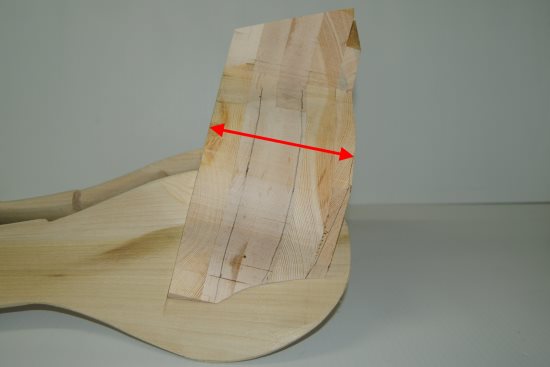
Stock thickness is a measurement of thickness front to back on a fork. A traditional Wade fork has 5" of stock, while most swell forks are 3 3/4" or less. Nowadays, there are many "Wade" forks being made with different stock thicknesses, and technically, I guess, they would need to be called modified Wades. This is where some of the other common names come in as both the "Lady Wade" and the "Ray Hunt Wade" usually have 4 1/2" stock. Sometimes the stock thickness is increased to balance the look of a larger horn. We have made them anywhere from 4 1/2" to 6" thick, at 1/4" intervals. (At 6", the gullet lip really sticks out a long way!!) But if you don't have that extra stock thickness compared to a regular fork, you don't have a Wade. You have a wood post slick fork, and you can call it whatever you want - except Wade!
6.) It has a higher top cut angle.
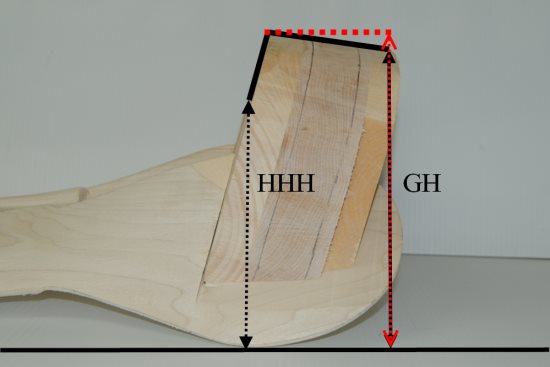
The top cut angle determines how level or downhill the top of the fork will look when sitting on a horse's back. Even though the top of the fork is cut at 90 degrees to the back or, more often, higher when the tree is on the horse, the lip ends up going downhill. And the thicker the stock, the lower the gullet lip ends up. So on a Wade, with a 5" stock thickness, you have to have a higher top cut angle to keep the gullet lip higher. (There are other reasons you don't want this high a top cut angle on forks with thinner stocks. You can read our Avoiding the Withers page to learn about them.) While we don't really cut the top cut angle on a wood post horn fork (that would mean we would cut off the horn!) where the gullet lip is placed relative to the top of the gullet marked on the back of the fork gives the higher top cut angle. This has both a functional purpose - so you have enough gullet clearance above the horse - and an aesthetic purpose - it looks a lot better. So when you see a "Wade" fork with gullet lip that really runs downhill, it looks kinda ugly (to our eyes anyway), because somebody missed one of the vital factors in making a Wade fork.
7.) It has a wider side cut angle.
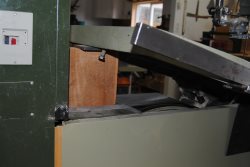 |
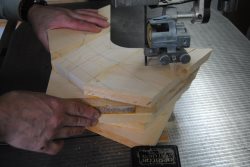 |
Part of what makes gives "the look" of the Wade is the fact that the sides of the fork are cut at an angle outwards. When we cut out a swell fork, the band saw table is flat and the sides are 90 degree to the back. When we cut out a Wade, we tilt the table so the side cut is angled outward. This is really hard to see on a finished tree because the whole thing is shaped and curved, but it really does make a difference in the final shape of the fork, and "Wade" trees that are made with the sides cut at 90 degrees sure look a lot different than the traditional Wade does.
So there, in all its technical detail, is what makes a Wade, a Wade - from the perspective of a tree maker who builds a lot of them. We put this up so that hopefully as more people understand the facts, some of the myths that are so prevalent about the "mystical" Wade saddle will be dispelled. It does have advantages when roping because of the wood post horn and the thinner gullet, but riding a Wade doesn't mean your saddle will fit your horse better, or even any differently than any other fork style. And it doesn't mean that you will automatically be a better rider either. Sorry about that...
